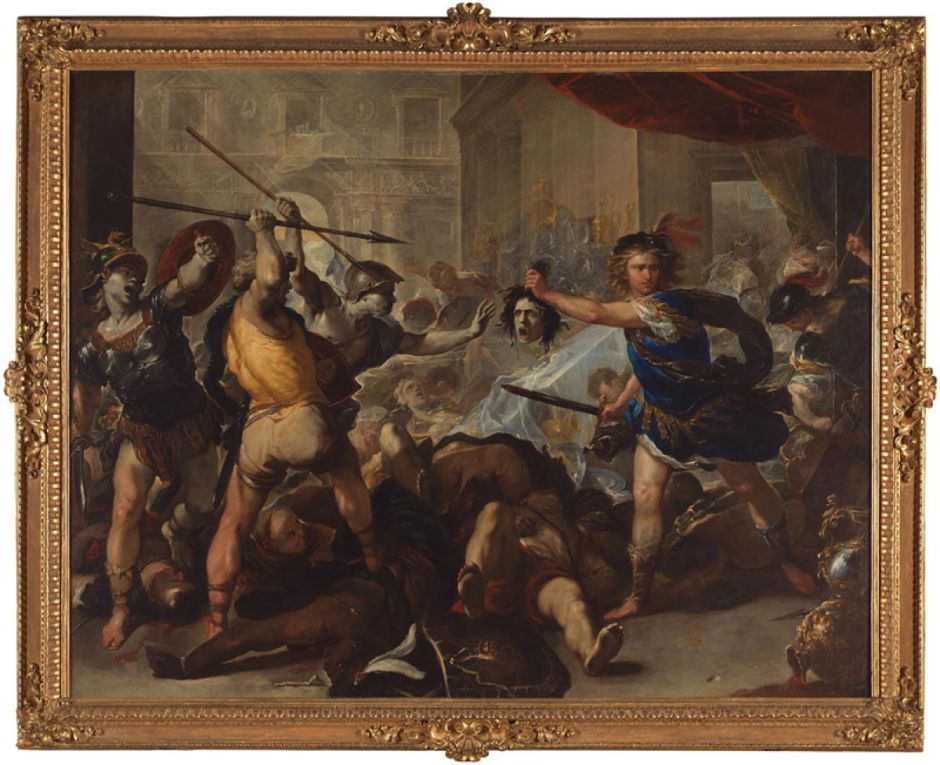Ovid concluded Book 4 of his Metamorphoses at the wedding feast of Perseus and Andromeda, and it is there that he opens Book 5. Perseus has just finished his stories of how he beheaded Medusa, and how Medusa came to have snakes in her hair in the first place. It’s at this point that the wedding feast gets out of hand – just as they always do in fiction.
The Story
As Perseus is completing his stories about Medusa, the palace is invaded by a rabble. Its ringleader is Phineus, the brother of King Cepheus, wielding a spear, who quickly establishes that, as far as he and his mob are concerned, Perseus has stolen his bride (who is also his niece). With a quick dig at Perseus’ conception by Danae with Jupiter’s ‘shower of gold’, Phineus and Cepheus argue.
Phineus then hurls his spear at Perseus, only to embed it in the furniture. Perseus throws it back, but Phineus has ducked behind cover, and it kills someone else. This is the cue for open warfare, which in turn prompts Minerva to appear and guard Perseus with her shield.
Ovid details a succession of violent deaths, in the course of which Perseus holds his own and remains unscathed. With his bride and her mother screaming for all they’re worth, the hall is awash with blood, and corpses are starting to stack up on the floor. Perseus realises that he is seriously outnumbered, and holds up the head of Medusa:
But when he saw his strength
was yielding to the multitude, he said,
“Since you have forced disaster on yourselves,
why should I hesitate to save myself? —
O friends, avert your faces if ye stand
before me!” And he raised Medusa’s head.
Thescelus answered him; “Seek other dupes
to chase with wonders!” Just as he prepared
to hurl the deadly javelin from his hand,
he stood, unmoving in that attitude,
a marble statue.
One by one, Perseus’ adversaries are transformed into stone. Only one of those defending him is caught out, but Phineus somehow manages to avoid looking at Medusa’s face. Phineus tries to excuse his conduct, claiming that he was only doing it for Andromeda. Perseus is not swayed:
And thus returned
the valiant Perseus; “I will grant to you,
O timid-hearted Phineus! as behoves
your conduct; and it should appear a gift,
magnanimous, to one who fears to move. —
Take courage, for no steel shall violate
your carcase; and, moreover, you shall be
a monument, that ages may record
your unforgotten name. You shall be seen
thus always, in the palace where resides
my father-in-law, that my surrendered spouse
may soften her great grief when she but sees
the darling image of her first betrothed.”
He spoke, and moved Medusa to that side
where Phineus had turned his trembling face:
and as he struggled to avert his gaze
his neck grew stiff; the moisture of his eyes
was hardened into stone. — And since that day
his timid face and coward eyes and hands,
forever shall be guilty as in life.
Perseus and Andromeda leave the palace filled with hundreds of statues, and return to Argos. There they find that Proetus has usurped power. He too feels the awesome power of Medusa’s gaze, as does another old enemy, Polydectes, the king of Seriphos.
This extraordinary wedding brings to mind the battle between Odysseus and Penelope’s suitors, although this story concludes very differently because of Perseus’ use of Medusa’s head. Ovid’s account is uniquely detailed and explicit, drawing parallels with Virgil’s account of Aeneas’ battle with Turnus over Lavinia, in the Aeneid.
The Paintings
Not as popular a subject in painting as Medusa or the rescue of Andromeda, Perseus’ wedding has still attracted some of the finest narrative painters prior to the nineteenth century, with the notable exception of Rubens.

Annibale Carracci and Domenichino combined their talents in painting this fresco of Perseus and Phineas (1604-06) in the Palazzo Farnese in Rome. As Perseus stands in the centre brandishing the Gorgon’s face towards his attackers, Andromeda and her parents shelter behind, shielding their eyes for safety.

In Giordano’s Perseus Turning Phineus and his Followers to Stone (c 1683), the process of petrification is made less obvious, but the carnage and mayhem better-developed.

Ricci’s Perseus Confronting Phineus with the Head of Medusa (c 1705-10) also shows the final moments of the battle, as Phineus cowers next to two of his henchmen who have almost completed the process of changing into stone.

Suprisingly, none of those paintings made any clear reference to Minerva’s protection of Perseus, which is clearly expressed in Jean-Marc Nattier’s undated painting of Perseus, Under the Protection of Minerva, Turns Phineus to Stone by Brandishing the Head of Medusa. The goddess, Perseus’ half-sister, is sat on a cloud to the right of and behind the hero. She wears her distinctive helmet, grips her spear, and her left hand holds her Aegis, a shield which bears the image of Medusa’s face – a relevant narrative closure here.
Perseus points his weapons away from himself and Minerva, and is looking up towards the goddess. In the foreground, one of Phineus’ party seems to be sorting through the silverware, perhaps intending to make off it.
This story seems to have vanished from the repertoire of narrative painting during the eighteenth century. Although Edward Burne-Jones worked on a drawing for his Perseus series, that never progressed any further, and I can find no trace of any painting of this wedding feast during the nineteenth century.
Each of these paintings has captured the bloodshed and chaos brought to the wedding feast. I confess to having a particular liking for the last painting, Nattier’s, which is most complete in terms of the narrative, and has the boldest composition.
The English translation of Ovid above is taken from Ovid. Metamorphoses. Tr. Brookes More. Boston. Cornhill Publishing Co. 1922, at Perseus. I am very grateful to Perseus at Tufts for this.

